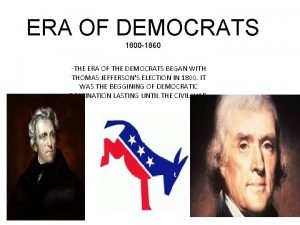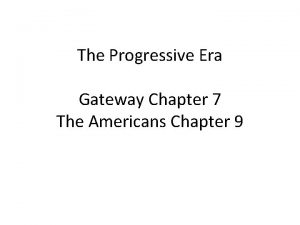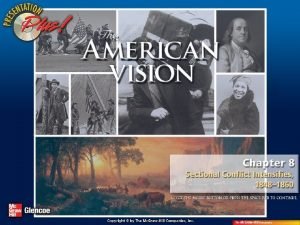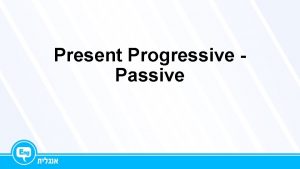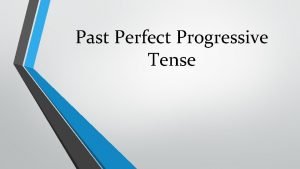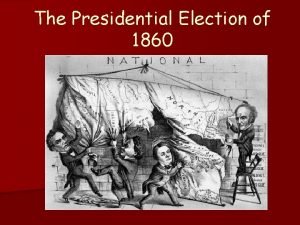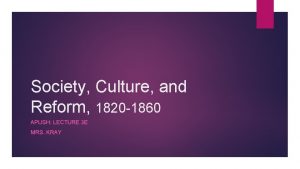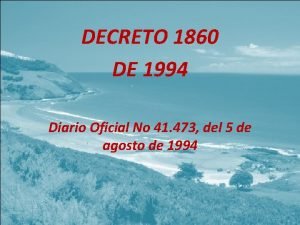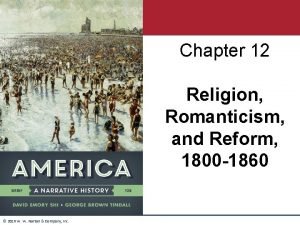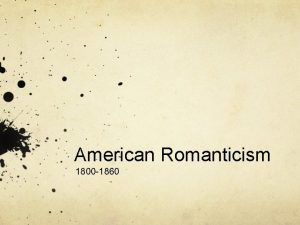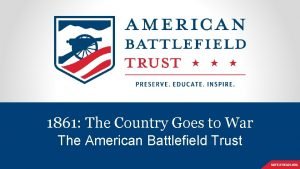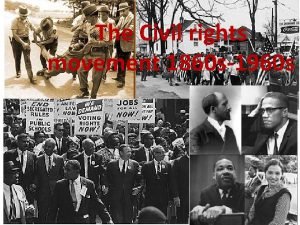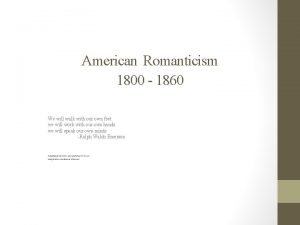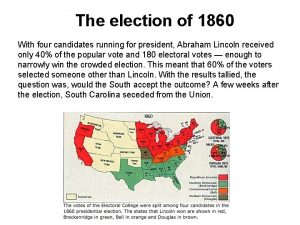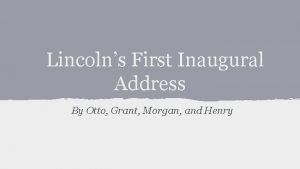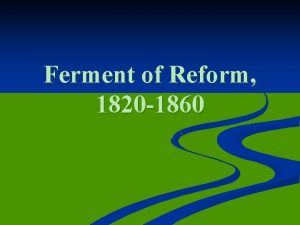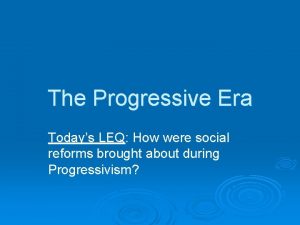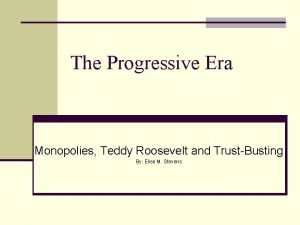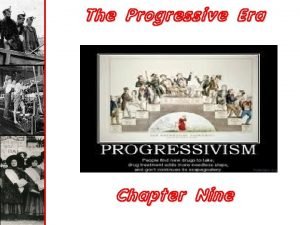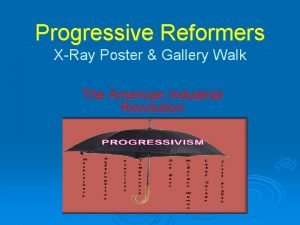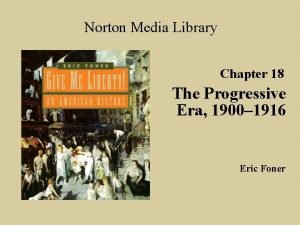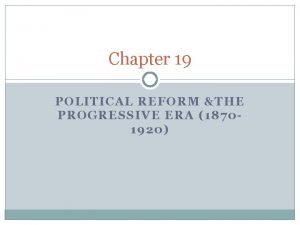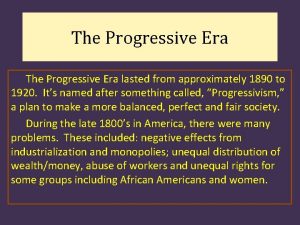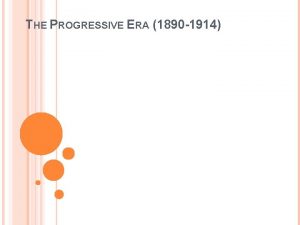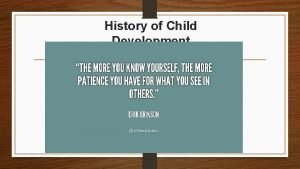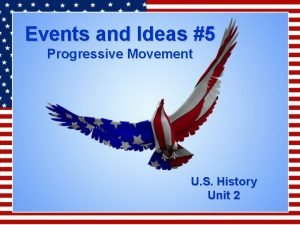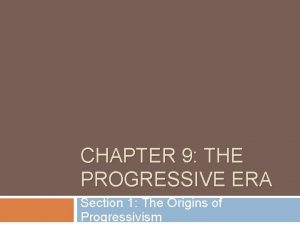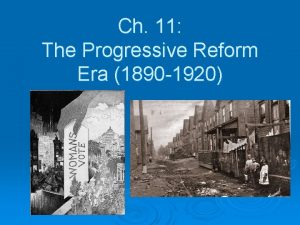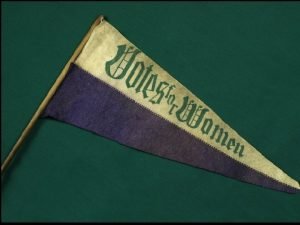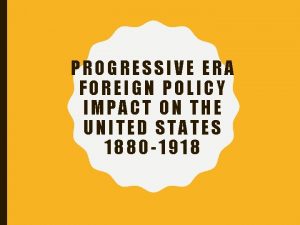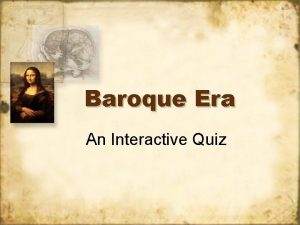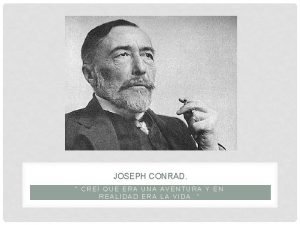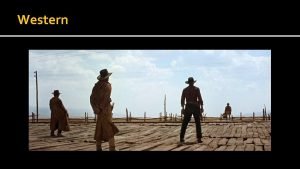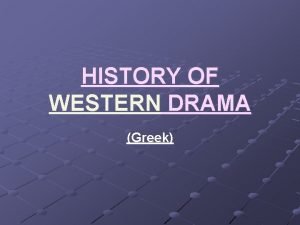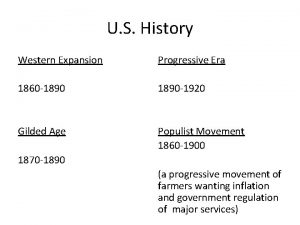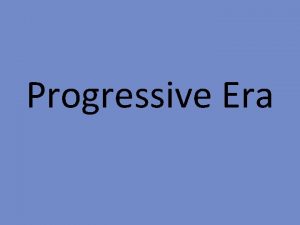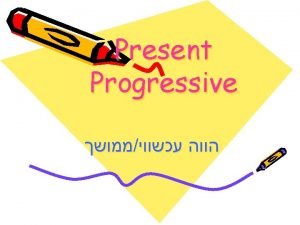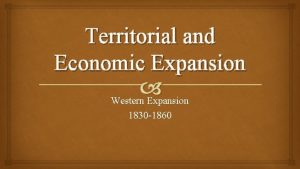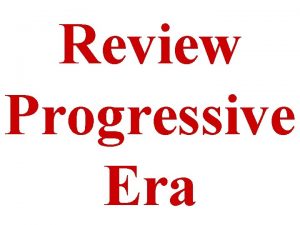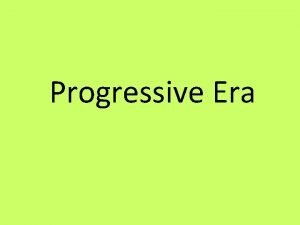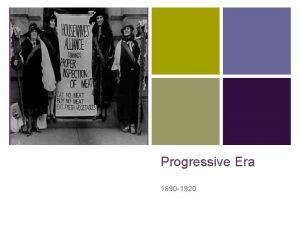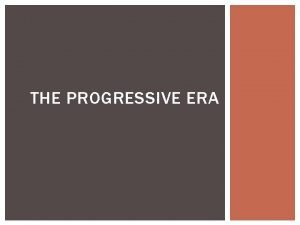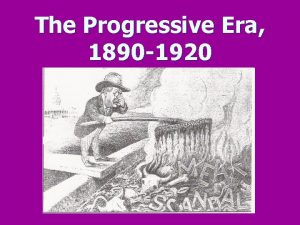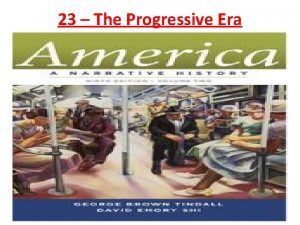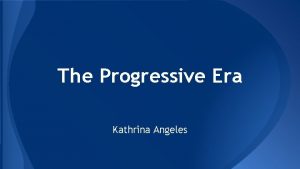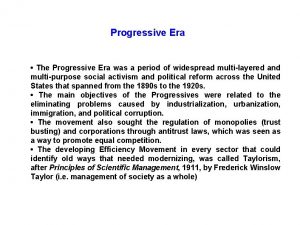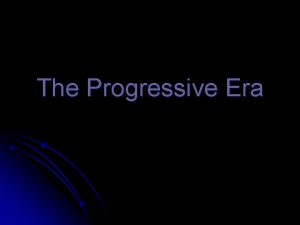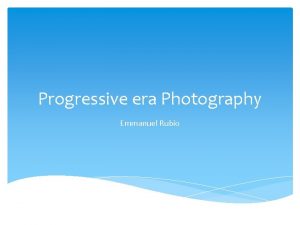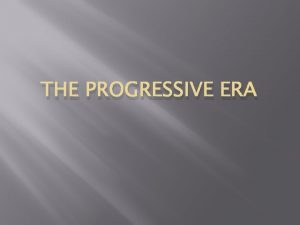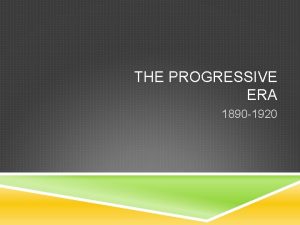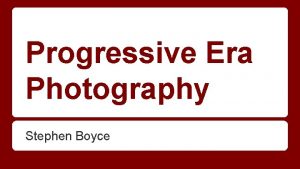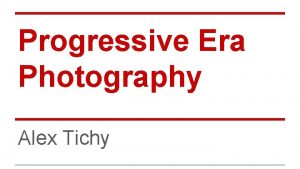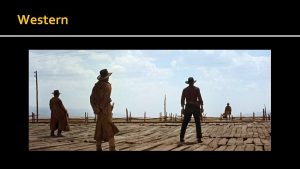U S History Western Expansion Progressive Era 1860













































- Slides: 45

U. S. History Western Expansion Progressive Era 1860 -1890 -1920 Gilded Age Populist Movement 1860 -1900 1870 -1890 (a progressive movement of farmers wanting inflation and government regulation of major services)

Progressive Era Circa 1890 -1920

Progressive Era: Defining Special Terms *=see notes 1. 2. 3. 4. 5. 6. 7. 8. 9. Progressive--reform Prohibition—making alcohol illegal City manager—appointed administrator of a city Referendum/initiative—when voters can decide state issues and laws with ballots Recall—taking a public official out of office after their election Primary—first election to select candidates for office Yellow journalism* Muckraking* Political corruption—using government for private gain 10. Conservation-environmentalism 11. “trustbuster”—politician who enforced anti-trust laws 12. Suffrage—right to vote 13. Civil Rights—working toward equal rights for races 14. NAACP—Civil Rights organization 15. Social gospel—duty to help the poor 16. Workmen’s Compensation—requirement of insurance for people hurt on the job 17. Populist Party—People’s Party who sponsored farmers’ issues

Film: Causes—Progressive Era and Today • The expansion of the U. S. into the West and the development of industry and cities in the East led to lots of issues and problems. • The Progressive Era attempted to address and solve those problems and issues. • Today’s world has lots of problems and issues that people embrace as causes. • What is your cause? • What would be your cause during the Progressive Era? • View the film and list 10 causes and star four you would take on.

The Progressive Era is driven by personalities! • • • Teddy Roosevelt Woodrow Wilson Susan B. Anthony Booker T. Washington W. E. B. Du. Bois William Randolph Hearst Pulitzer Rockefeller and Carnegie Middle class women Frank Lloyd Wright • Northern Issues • Southern Issues • Western Issues

Yellow Journalism Exaggerated news to sell newspapers Tended to sensationalize events for the purpose of entertainment and profit Most notable were papers owned by Hearst and Pulitzer

Muckrakers • Early 20 th century journalists who exposed illegal business practices, social injustices and corrupt urban political bosses • Exposed urban problems • The rise of mass circulation newspapers and magazines enabled muckrakers to reach a large audience. • Leading muckrakers included Upton Sinclair, Jacob Riis and Ida Tarbell, Ida Wells, Lewis Hine, Thomas Nast, Lincoln Steffens


TR called Upton Sinclair a muckraker

Film: The Progressive Movement (for each topic, write a detailed sentence) 1. 2. 3. 4. 5. 6. 7. Women Take the Lead A Clash of Cultures Muckrakers and Bosses Fighting the Trust Roosevelt and Wilson Freedom? Whose Freedom? Women Suffragists

• William Tweed, the boss of the Tammany Hall Democratic party political machine • He was arrested, tried and imprisoned

Thomas Nast exposed the political machine of Tammany Hall and its political boss, William Tweed


Nast drew the symbols of the two political parties

Nast also drew this familiar image

Reconstruction—rebuilding the South after the Civil War • Northern occupation • Southern resentments • Temporary rights for freedmen • Freedmen’s Bureau • Cycle of poverty started with sharecropping • Interpret the cartoon…

Post Civil War Efforts and Legacy • Reconstruction (1865 -1877) • Textile mills and infrastructure (“New South”) • Republican dominance • Solid South voted Democrat • Black Codes and “Jim Crow” legislation • Rise and fall of the Klan • Segregation and legacy of sharecropping, tenant farming, and poverty

Nast exposed Reconstruction atrocities 1. Describe the horrors of Reconstruction (186577) as shown in the political cartoon. 2. How would Northerners respond to this cartoon? Southerners? 3. How would African Americans respond?

Civil Rights Issues • Segregation—two kinds • De jure segregation— “by law”—in South • De facto segregation— “by tradition”—in North

Civil Rights Leaders • Booker T. Washington • W. E. B. Du. Bois

The Atlanta Compromise • The Atlanta Compromise was an agreement struck in 1895 between Booker T. Washington, president of the Tuskegee Institute, and other African-American leaders, and Southern white leaders. It was opposed by W. E. B. Du Bois and other African-American leaders. • Education was limited to vocational programs • It promoted “accommodation”, not activism

Plessy v. Ferguson • Louisiana train • Southern tradition vs. 14 th Amendment (rights of citizenship) • Decision was a HUGE SETBACK for Civil Rights • Promoted “separate but equal” doctrine and extended segregation for 70 more years!

Temperance led to Prohibition • Frances Willard led the Women’s Christian Temperance Union (WCTU) • Carrie Nation “axed” saloons and bars • 18 th Amendment passed in 1920 (was repealed by 21 st Amendment in 1933)

Women marched for suffrage (the right to vote!)

Women got the vote in 1920! • See video of women’s suffrage • See Triangle Shirtwaist Fire (PBS: American Experience)

Helen Keller (1880 -1968)

Music • Ragtime by Scott Joplin • Tin Pan Alley songs by George M. Cohan, Irving Berlin, George and Ira Gershwin

J. P. Morgan • Considered most powerful man in the country • Until… • Sued by government over monopolies • Sealed TR’s reputation as a trustbuster

Roosevelt • http: //www. history. c om/topics/uspresidents/theodoreroosevelt

• YMCA and YWCA—promoted health of youth • Disasters led communities to reform: – Examples: Blizzard of 1888 (led to National Weather Service) – Galveston Hurricane of 1900 (6000 dead—led to sea wall) – Floods of Mississippi Delta and Ohio River • Cities controlled utilities • Changed view of what government should be and should do

1910 --New ideas of Government? • • • Be accountable to the people Curb the power of the wealthy Protect workers Improve lives of citizens Become more efficient and less corrupt Control only utility businesses (water, gas, electricity)

A New Brand of Patriotism • The Pledge of Allegiance was written in the 1890 s by Francis Bellamy • changed in 1920 s by Daughters of the American Revolution • changed again in 1950 s by Knights of Columbus • “America the Beautiful was written by Katherine Bates in the 1890 s


Progressive Era Posters Raised Awareness

Sort the issues 1. Home 2. Conservation 3. State/Local Reforms 4. Finance 5. Politicians 6. Women 7. Civil Rights 8. Labor 9. Federal Legislation 10. Other Reformers

Answers to 1 -10 • 1. Home Issues: social gospel, birth control, women’s suffrage, meat, education, poverty, architecture, prohibition, 18 th amendment, 19 th amendment, child labor laws, universities, yellow journalism, muckraking • 2. Conservation Issues (see #XIII): water rights, forest management, national parks, public parks, landscaping, Sierra Club, Boy Scouts, T. Roosevelt’s presidency, U. S. Forest Service, Frederick Law Olmstead

• 3. State and Local Reforms: city managers, commissioners, secret ballot, referendums, initiatives, direct primaries, recall elections, prohibition, political corruption and machines, meat, food and drugs, settlement houses, poverty, lynching, architecture, conservation, women’s rights, birth control, socialism, unions, civil rights, education, social gospel, corporate welfare, segregation

• 4. Finance Reform: trustbusting, Sherman Anti-trust Act, Clayton Anti-trust Act, History of Standard Oil, break up of the Rockefeller monopoly, Federal Reserve Bank, corporate welfare, Workmen’s Compensation, unions, Department of Labor • 5. Politicians: T. Roosevelt, W. Wilson, C. E. Hughes, H. Hoover, W. J. Bryan, Al Smith, Eugene Debs, Robert La Follette

• 6. Women’s Issues: suffrage, education, child labor, prohibition, universities, social gospel, Civil Rights, architecture, settlement houses, social work, poverty, meat, food, drugs, political corruption, muckraking, reforming local and state governments • 7. Civil Rights: lynching, education, African American universities, NAACP, Niagra Movement, Plessy case, segregation, “separate but equal”, unions, poverty

• 8. Labor: unions, socialists, Workmen’s Compensation, income tax, corporate welfare, Department of Labor, child labor laws, mandatory education laws, Meat Inspection and Pure Food and Drug Act, trustbusting, Sherman Anti-trust Act, Clayton Anti-trust Act, social gospel • 9. Federal Legislation: Amendments 16, 17, 18, 19, Federal Reserve Act, Sherman Anti-trust Act, Clayton Anti-trust Act, Workmen’s Compensation, Meat Inspection Act, Pure Food and Drug Act, Creation of U. S. Parks and Forests, child labor laws, mandatory education laws, National Park Service

• 10. Other Reformers (not politicians): Ida Wells, Upton Sinclair, Margaret Sanger, Frank Lloyd Wright, Louis Sullivan, Jane Addams, Susan B. Anthony, Elizabeth Cady Stanton, Du. Bois and Washington, Jacob Riis, Lincoln Steffens, Thomas Nast, Pulitzer and Hearst, Lewis Brandeis, Henry Ford

STAAR Amendments (Federal Legislation) 13 th—free 14 th—citizens 15 th—vote 16 th—income tax 17 th—election of senators 18 th—no alcohol 19 th—women’s vote

Who is on STAAR? Politicians, Reformers, Activists 1. 2. 3. 4. 5. 6. 7. 8. 9. 10. 11. 12. 13. 14. Hearst and Pulitzer— publishers Pu pu Wright and Sullivan—architects T. Roosevelt—conservation/ trustbuster R tr Susan B. Anthony—suffrage Su su Eugene Debs—union and socialist leader Book T. Washington—Civil Rights education W. E. B. Du. Bois—Civil Rights—NAACP Jane Addams—Hull House/social worker Henry Ford—cars and corporate welfare (affordable) Upton Sinclair—The Jungle Up Ida Wells—exposed lynching numbers Frances Willard—leader of Women’s Christian Temperance Union Woodrow Wilson—President/Workmen’s Compensation William Jennings Bryan—Populist candidate for President--lion

STAAR Ideas 1. 2. 3. 4. 5. 6. 7. 8. 9. 10. 11. 12. 13. 14. Political machines—organizations using rewards and gain for political service Civil service reform—efforts to end political corruption Labor unions—organizations of workers Women’s suffrage—women’s right to vote Civil Rights—effort toward political and social equality for minorities Social Gospel—application of Christian ethics to social problems Initiative—issue put to a vote after a petition Referendum—voters accept or reject a proposal Recall—voters can remove an elected official through their vote Muckrakers—journalists who expose the negatives in society Eugenics— “good genes”—effort to alter genetic traits—a form of “scientific racism” based on faulty “science” Prohibition—legal ban on sale or transportation of alcohol Tin Pan Alley—the “new” music of New York Populists—third party supported by farmers

Illustration of Progressive Issue • • • Topic (number and title) Terms/Issues Picture—can be drawn or computer printout Vivid and clear words and picture Bonus points for color (Consider this a “cheat sheet”)
 What era was the 1800
What era was the 1800 Gateway to us history chapter 7 the progressive era
Gateway to us history chapter 7 the progressive era Lesson 1 slavery and western expansion
Lesson 1 slavery and western expansion Present passive progressive
Present passive progressive Past perfect v past simple
Past perfect v past simple Present perfect continuous function
Present perfect continuous function Border states in 1860
Border states in 1860 Ancetre de l'aspirateur
Ancetre de l'aspirateur The romantic period in american literature
The romantic period in american literature Definition
Definition Apush 1820 to 1860
Apush 1820 to 1860 Decreto 1860 de 1994
Decreto 1860 de 1994 Chapter 12 religion romanticism and reform
Chapter 12 religion romanticism and reform American romanticism 1800 to 1860 worksheet answers
American romanticism 1800 to 1860 worksheet answers South carolina 1860
South carolina 1860 1860
1860 American romanticism 1800 to 1860 worksheet answers
American romanticism 1800 to 1860 worksheet answers American romanticism 1800 to 1860 worksheet answers
American romanticism 1800 to 1860 worksheet answers Map of 1860
Map of 1860 Election of 1860 pie chart
Election of 1860 pie chart American reform movements between 1820 and 1860
American reform movements between 1820 and 1860 South africa 1860
South africa 1860 Progressive era leq
Progressive era leq What are mukrakers
What are mukrakers Progressive era monopolies
Progressive era monopolies Progressive era dbq answers
Progressive era dbq answers Progressive era posters
Progressive era posters Chapter 18 the progressive era
Chapter 18 the progressive era Chapter 19 political reform and the progressive era
Chapter 19 political reform and the progressive era Initiative progressive era definition
Initiative progressive era definition The progressive era lasted from
The progressive era lasted from Promoting moral improvement
Promoting moral improvement John dewey progressive era
John dewey progressive era Progressive era worksheets
Progressive era worksheets Chapter 9 the progressive era section 1 answers
Chapter 9 the progressive era section 1 answers Chapter 11 the progressive reform era
Chapter 11 the progressive reform era Anne dallas dudley
Anne dallas dudley Progressive era foreign policy
Progressive era foreign policy The wizard of oz: parable on populism
The wizard of oz: parable on populism Https://play.kahoot.
Https://play.kahoot. Baroque music quiz
Baroque music quiz Elizabethan era vs victorian era
Elizabethan era vs victorian era Creí que era una aventura y en realidad era la vida
Creí que era una aventura y en realidad era la vida Vi uma estrela tão alta
Vi uma estrela tão alta History of the western genre
History of the western genre History of western drama
History of western drama
